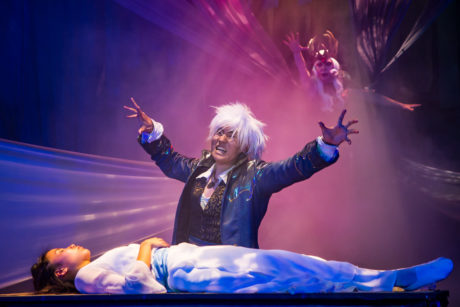Briar Rose. Brunhilde. Talia. Rosamond. Aurora. Over the centuries Sleeping Beauty has been known by many names, but the long abiding folk tale of good conquering evil and love conquering all, has captured audiences around the world, inspiring writers from Charles Perrault to the Brothers Grimm to Italian poet Giambattista Basile to the great composer Pyotr Ilych Tchaikovsky and ballet choreographer Marius Petipa (their 1890 ballet preceded their great Classical Swan Lake by five years) to Walt Disney. The Metro D.C. region’s beloved Synetic Theater has undertaken a new, and, of course, wordless adaptation of this classic tale under the creative guidance of the theater’s founders and driving force Paata and Irina Tsikurishvili. Nathan Weinberger adapted the story into an emotion-filled libretto ready to be imbued with movement, sound, light, and color.

The Synetic trademarks – no dialogue, inventive scenery and costumes that use classic theatrical tricks and technological innovations, choreography that draws from ballet, folk and even martial arts, a dramatic build to a dynamic climax all told within 90 intermissionless minutes — remain pillars in this production. While the story, an ancient folktale adapted and readapted over the centuries, is far simpler than Synetic’s daring and mind-bending productions of the company’s now-classic silent Shakespeare adaptations, it doesn’t flag in the able hand of director and choreographer Paata Tsikurishvili and Irina Tsikurishvili, respectively. Accompanied by a dramatic score, which subtly quotes Tchaikovsky, created by resident composer Konstantine Lortkipanidze that propels the performers into grandly expressive moments and nearly balletic movement sequences, and a stage hung with swaths of floor-length silks designed by Phil Charlwood that transform from forests to palace with the magic of lighting and an ever evolving video montage by Riki Kim and lighting design that includes moving silhouettes in the style of Indonesian shadow puppets by Brian Allard, Sleeping Beauty is fully realized as an extravagant production featuring equal emphasis on music, movement, art, light, sound, and media in a fashion that provides a fantastically rich canvas on which this tale is viscerally painted.
While the title character, Sleeping Beauty, here named Briar Rose, is played with lovely innocence, grace and playful curiosity by Eliza Smith (an alumnae of Synetic Theater’s Teen Program), neither she, nor her handsome (bleached) blonde prince, Zana Gankhuyag (another teen program grad), who is learning to use his inherited sorcerery powers, is the most interesting character in this story of love overcoming and evil and vindictive curse.
The true star and most intriguing character is the Witch. Here, with a back story that is told in a prologue of sorts, we learn the reason for the evil Witch’s curse on the king’s new daughter, Briar Rose. Played with magnificent contempt and hatred by Irina Tsikurishvili, here with long bleached blonde locks, a fabulous black cape and piercing darkly shadowed eyes and pale, nearly white skin, she is far from a cartoonish Maleficent, a Disney witch. The cartoonish portraits are of the three good fairies, who raise Briar Rose, after the Witch promulgates her curse. Their multihued costumes, magenta, tangerine and emerald, with wings and bat-like masks and their exaggerated goofy and giddy demeanors allow for some gentleness and humor by Kathy Gordon, Francesca Blume, and Emily Whitworth in the wake of Tsikurishvili’s Witch.

And, yet, that Witch has seen her beloved forest home decimated by a fire started by the king’s army. Her animal kingdom – represented by leaping, antlered dancers – succumbs to flames, only she and her son are spared. This is the source of her rage, her curse, her death wish for the new-born royal daughter. Then, after her son and Briar Rose are grown, meet and fall in love, we see a true moral struggle as Tsikurishvili’s Witch battles with herself, her son and the Sleeping Beauty before coming to acceptance.
It’s a spectacular moment, all crafted with Synetic’s astonishing creativity through multimedia, aural, kinesthetic means. What started as a sweet fairytale retold, becomes a testament to love, both romantic and maternal, triumphing over vengeance. Synetic has again re-envisioned a classic through its unique artistic collaborative process into a satisfying 90-minutes of full-bodied and fully embodied theater. While it may not be Disney-appropriate for the youngest viewers due of the intensity of the highly dramatic portrayals of the fire and the climactic moments, Synetic’s Sleeping Beauty provides a highly visceral theater-going experience for older audience members.
90 minutes, with no intermission.
Sleeping Beauty plays through January 9, 2017, at Synetic Theater – 1800 South Bell Street, in Crystal City, VA. For tickets, call the box office at (866) 811-4111, or purchase them online.
RATING:





